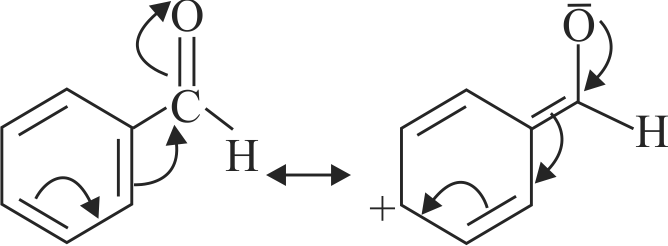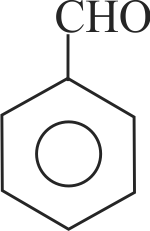323676
Assertion :
Fehling's solution can be used to distinguish benzaldehyde from acetaldehyde.
Reason :
The \(\mathrm{C}-\mathrm{H}\) bond of \(\mathrm{CHO}\) group in benzaldehyde is stronger than \(\mathrm{C}-\mathrm{H}\) bond of \(\mathrm{CHO}\) group in acetaldehyde.
323679
How many of the following compounds will NOT reduce Fehling's solution?
\({\mathrm{\mathrm{HCHO}, \quad \mathrm{C}_{6} \mathrm{H}_{5} \mathrm{COCH}_{3}, \quad \mathrm{C}_{6} \mathrm{H}_{5} \mathrm{COC}_{6} \mathrm{H}_{5}}}\), \({\mathrm{\left(\mathrm{CH}_{3}\right)_{3} \mathrm{C}-\mathrm{CHO}, \quad \mathrm{C}_{6} \mathrm{H}_{5} \mathrm{CHO}, \quad \mathrm{CH}_{3} \mathrm{CHO}}}\), \({\mathrm{\mathrm{m}-\mathrm{HOC}_{6} \mathrm{H}_{4} \mathrm{CHO}, \mathrm{p}-\mathrm{O}_{2} \mathrm{NC}_{6} \mathrm{H}_{4} \mathrm{CHO}}}\).
323676
Assertion :
Fehling's solution can be used to distinguish benzaldehyde from acetaldehyde.
Reason :
The \(\mathrm{C}-\mathrm{H}\) bond of \(\mathrm{CHO}\) group in benzaldehyde is stronger than \(\mathrm{C}-\mathrm{H}\) bond of \(\mathrm{CHO}\) group in acetaldehyde.
323679
How many of the following compounds will NOT reduce Fehling's solution?
\({\mathrm{\mathrm{HCHO}, \quad \mathrm{C}_{6} \mathrm{H}_{5} \mathrm{COCH}_{3}, \quad \mathrm{C}_{6} \mathrm{H}_{5} \mathrm{COC}_{6} \mathrm{H}_{5}}}\), \({\mathrm{\left(\mathrm{CH}_{3}\right)_{3} \mathrm{C}-\mathrm{CHO}, \quad \mathrm{C}_{6} \mathrm{H}_{5} \mathrm{CHO}, \quad \mathrm{CH}_{3} \mathrm{CHO}}}\), \({\mathrm{\mathrm{m}-\mathrm{HOC}_{6} \mathrm{H}_{4} \mathrm{CHO}, \mathrm{p}-\mathrm{O}_{2} \mathrm{NC}_{6} \mathrm{H}_{4} \mathrm{CHO}}}\).
323676
Assertion :
Fehling's solution can be used to distinguish benzaldehyde from acetaldehyde.
Reason :
The \(\mathrm{C}-\mathrm{H}\) bond of \(\mathrm{CHO}\) group in benzaldehyde is stronger than \(\mathrm{C}-\mathrm{H}\) bond of \(\mathrm{CHO}\) group in acetaldehyde.
323679
How many of the following compounds will NOT reduce Fehling's solution?
\({\mathrm{\mathrm{HCHO}, \quad \mathrm{C}_{6} \mathrm{H}_{5} \mathrm{COCH}_{3}, \quad \mathrm{C}_{6} \mathrm{H}_{5} \mathrm{COC}_{6} \mathrm{H}_{5}}}\), \({\mathrm{\left(\mathrm{CH}_{3}\right)_{3} \mathrm{C}-\mathrm{CHO}, \quad \mathrm{C}_{6} \mathrm{H}_{5} \mathrm{CHO}, \quad \mathrm{CH}_{3} \mathrm{CHO}}}\), \({\mathrm{\mathrm{m}-\mathrm{HOC}_{6} \mathrm{H}_{4} \mathrm{CHO}, \mathrm{p}-\mathrm{O}_{2} \mathrm{NC}_{6} \mathrm{H}_{4} \mathrm{CHO}}}\).
323676
Assertion :
Fehling's solution can be used to distinguish benzaldehyde from acetaldehyde.
Reason :
The \(\mathrm{C}-\mathrm{H}\) bond of \(\mathrm{CHO}\) group in benzaldehyde is stronger than \(\mathrm{C}-\mathrm{H}\) bond of \(\mathrm{CHO}\) group in acetaldehyde.
323679
How many of the following compounds will NOT reduce Fehling's solution?
\({\mathrm{\mathrm{HCHO}, \quad \mathrm{C}_{6} \mathrm{H}_{5} \mathrm{COCH}_{3}, \quad \mathrm{C}_{6} \mathrm{H}_{5} \mathrm{COC}_{6} \mathrm{H}_{5}}}\), \({\mathrm{\left(\mathrm{CH}_{3}\right)_{3} \mathrm{C}-\mathrm{CHO}, \quad \mathrm{C}_{6} \mathrm{H}_{5} \mathrm{CHO}, \quad \mathrm{CH}_{3} \mathrm{CHO}}}\), \({\mathrm{\mathrm{m}-\mathrm{HOC}_{6} \mathrm{H}_{4} \mathrm{CHO}, \mathrm{p}-\mathrm{O}_{2} \mathrm{NC}_{6} \mathrm{H}_{4} \mathrm{CHO}}}\).


